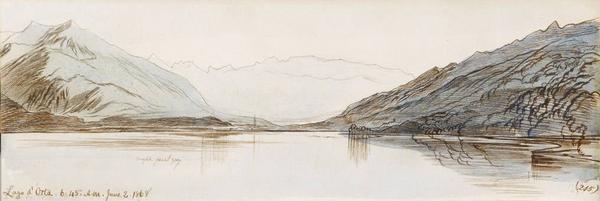Introducing an exhibition at the British Library in 1987, the curator wrote: ‘If the camera had been invented by the Venerable Bede in the year 700, few of the pictures in this exhibition would have been made’. Much of what is invaluable to know about the appearance of the world before photography is potentially available in public and private collections in Britain and around the world, but often difficult to access and not fully catalogued.
Now an extraordinary project is being launched. The Watercolour World follows the success of a charitable project set up by Dr Fred Hohler to catalogue all 230,000 oil paintings in British public collections. ‘It was during this 10-year project that the obscurity into which our watercolour collection had fallen became increasingly apparent.’ The subjects and artists of many watercolours in museums were unidentified, most were unframed and some in poor condition. It seemed that a great asset was being wasted.
The Watercolour World project aims to create a world-wide, geographically-indexed online archive of documentary watercolours up to 1900, including topographical, anthropological and botanical images covering observed events, people, places, landscapes and seascapes. The value of such a resource has been demonstrated by the series of reports on the British coastline for the Crown Estate and Historic England, which used watercolours among other historical records.
Untitled (Iguana), 1585-1593, John White
© Trustees of the British Museum, CC BY-NC-SA 4.0
A number of developments in 18th-century Britain gave birth to a new way of observing and recording the world. Watercolour was a perfect medium to catch the appearance of plants, people and things as well as places. It was comparatively portable and had proved its value in the 1580s when taken to the first North American colony by John White.
The tradition of military surveyors making watercolour views of ports and fortifications goes back to English and Flemish artists employed by Henry VIII. Spies too. At least one Dutch draughtsman just happened to be on the North Kent coast a year before their navy burned Charles II’s fleet in the Medway. In the mid 18th century as the first British Empire was coming into existence, wars were fought with a new professionalism, and an aspect of this was the establishment of military academies where officers were taught to draw as a vital military skill.
At the same time antiquarianism, the study of the remains of the past, and topography, the recording of the actual appearance of the present, swept the country as manifestations of the Enlightenment, which sought to understand the world through scientific enquiry. During the intervals of Continental peace in the 18th century Grand Tourism gave a further boost to view-taking. The richest young ‘milord’ might travel with a personal draughtsman; other patrons paid favourite artists to make their own tours. Some artists stayed in Italy for several years, paying their way with views for Tourists to take home like holiday snaps or postcards.
Allahabad, from the Right Bank of the Jumna, 1865, William Simpson
Image credit Yale Center for British Art, Public Domain
The Pacific voyages of Captain Cook and his French competitors carried artists, and artists followed European arms and commerce around the globe. 19th-century travelling artists such as David Roberts, Edward Lear, and William Simpson continued to enthuse amateurs to follow in their footsteps, while William Daniell’s A Voyage Round Great Britain, 1813–1823 familiarised subjects close to home.
The Watercolour World is immensely ambitious. Public collections are immense – and then there is the whole non English-speaking world.
Even that may not be the half of it. The intention is also to collate private collections including those of descendants of 18th- and 19th-century amateurs. This could take the total into the millions.
Dawn on Lago D’Orta, June 1868, Edward Lear
Image © Guy Peppiatt Fine Art, All Rights Reserved
Huon Mallalieu is a freelance writer and the author of The Dictionary of British Watercolour Artists. This is an adaptation of an article that first appeared in the 21 March, 2018, issue of Country Life magazine.







